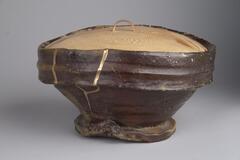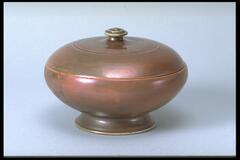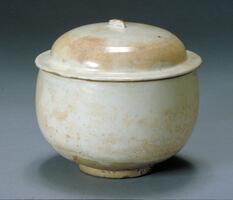14 UMMA Objects
14 UMMA Objects
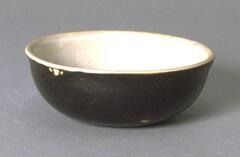
Chinese (Chinese (culture or style))
Jar Cover
800 – 999
Given in memory of James Marshall Plumer by John Maxon, Architecture and Design '41
1961/2.1
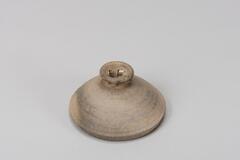
Korean (Korean (culture or style))
Lid for Bowl
400 – 599
Gift of Ok Ja Chang and the Chang Family
2009/2.77
![A ceramic lid for a matching bowl. Outfitted with a small, round and tapered handle.<br />
<br />
This yellow, low-fired earthenware vessel consists of a body and a lid. It is made from fine clay mixed with a small amount of fine sand particles. Fine, incised horizontal lines run around the body. The gallery that supports the lid rests at a slight incline, and the vessel mouth slopes slightly inwards. The lower part of the body rapidly tapers inwards before joining the base, the center of which is indented. The lid features a low, flat knob. The round, upper part of the lid meets the lip at a slight angle.[Korean Collection, University of Michigan Museum of Art (2017) p. 45]<br />
A ceramic lid for a matching bowl. Outfitted with a small, round and tapered handle.<br />
<br />
This yellow, low-fired earthenware vessel consists of a body and a lid. It is made from fine clay mixed with a small amount of fine sand particles. Fine, incised horizontal lines run around the body. The gallery that supports the lid rests at a slight incline, and the vessel mouth slopes slightly inwards. The lower part of the body rapidly tapers inwards before joining the base, the center of which is indented. The lid features a low, flat knob. The round, upper part of the lid meets the lip at a slight angle.[Korean Collection, University of Michigan Museum of Art (2017) p. 45]<br />
](/media/W1siZiIsIjIwMjIvMDkvMjQvMm9nbHVzanppOF9kZWZhdWx0LmpwZyJdLFsicCIsInRodW1iIiwiMjQweDIwMCJdXQ?sha=88066081a177047d)
Korean (Korean (culture or style))
Lid for Bowl
400 – 599
Gift of Ok Ja Chang and the Chang Family
2009/2.75B
![This type of bowl, with an inverted rim and hollow inside, is known as an <em>okbari</em> or <em>omok-bansanggi</em> (concave tableware). Considering its size, it was probably used for serving steamed rice. The tall foot was made separately before being attached. One line is incised around the outer rim of the bowl, which gently slopes inwards. The nipple-shaped handle is fixed to the top of the lid by a nail. The head of a nail joining the foot to the base of the bowl is visible on the indented base of the foot.
<p>[Korean Collection, University of Michigan Museum of Art (2017), 249]</p>
This type of bowl, with an inverted rim and hollow inside, is known as an <em>okbari</em> or <em>omok-bansanggi</em> (concave tableware). Considering its size, it was probably used for serving steamed rice. The tall foot was made separately before being attached. One line is incised around the outer rim of the bowl, which gently slopes inwards. The nipple-shaped handle is fixed to the top of the lid by a nail. The head of a nail joining the foot to the base of the bowl is visible on the indented base of the foot.
<p>[Korean Collection, University of Michigan Museum of Art (2017), 249]</p>](/media/W1siZiIsIjIwMjIvMDkvMjQvMXltYnU1bTZzOV9kZWZhdWx0LmpwZyJdLFsicCIsInRodW1iIiwiMjQweDIwMCJdXQ?sha=209b642fb884c3d4)
Korean (Korean (culture or style))
Covered Bowl
1900 – 1950
Gift of Bruce and Inta Hasenkamp and Museum purchase made possible by Elder and Mrs. Sang-Yong Nam
2004/1.304A&B
![A rectangluarly shaped woven basket with rounded edged. The bottom half and the lid of the basket are trimmed with strips of pine. The two pieces are of two slightly different sizes, making the lid fit into the bottom piece.<br />
<br />
These wicker baskets are rimmed with willow strips on both the interior and the exterior. Wicker baskets such as these were used as sewing baskets, food containers, or for other various purposes. The willow strips are sewn firmly together at their joints. On one each side of the lid and body of plate 358 (2009/2.56) is a faded inscription written that reads “Seong □ 2-gu Bongsandaek (성□2구 봉산댁; possibly a reference to a lady from Bongsan, living in Seong □ 2 [i]-gu).”
<p>[Korean Collection, University of Michigan Museum of Art (2017) p. 278]</p>
A rectangluarly shaped woven basket with rounded edged. The bottom half and the lid of the basket are trimmed with strips of pine. The two pieces are of two slightly different sizes, making the lid fit into the bottom piece.<br />
<br />
These wicker baskets are rimmed with willow strips on both the interior and the exterior. Wicker baskets such as these were used as sewing baskets, food containers, or for other various purposes. The willow strips are sewn firmly together at their joints. On one each side of the lid and body of plate 358 (2009/2.56) is a faded inscription written that reads “Seong □ 2-gu Bongsandaek (성□2구 봉산댁; possibly a reference to a lady from Bongsan, living in Seong □ 2 [i]-gu).”
<p>[Korean Collection, University of Michigan Museum of Art (2017) p. 278]</p>](/media/W1siZiIsIjIwMjIvMDkvMjQvNG0xb3JlcWlnMV9kZWZhdWx0LmpwZyJdLFsicCIsInRodW1iIiwiMjQweDIwMCJdXQ?sha=349fad738bc188d5)
Korean (Korean (culture or style))
Lidded Basket for Sewing
1850 – 1950
Gift of Ok Ja Chang and the Chang Family
2009/2.51
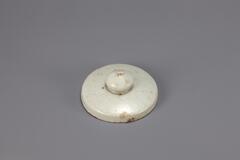
Korean (Korean (culture or style))
Burial Set (15 plates, 16 bowls and 6 lids)
17th century
Gift of Ok Ja Chang and the Chang Family
2009/2.79.1

Korean (Korean (culture or style))
Cinerary urn with concentric circles design
600 – 799
Gift of Mrs. Caroline I. Plumer for the James Marshall Plumer Collection
1973/2.34A&B
![Flaring base with spherical food storage bowl on top. The base is cut with evenly spaced rectangular holes. The lid is incised with a repeating design.<br />
<br />
This is a grayish white, high-fired stoneware lidded stem cup. The lid features a button-shaped knob at the center, around which a thin circle is inscribed. Triangular line designs are contained within the circle, which is surrounded by a row of semicircles with dots inside. The single-tiered, perforated, trumpetshaped pedestal has three rectangular openings. The pedestal flares widely outwards towards its bottom, which has a horizontally spreading edge.
<p>[Korean Collection, University of Michigan Museum of Art (2017) p. 62]</p>
Flaring base with spherical food storage bowl on top. The base is cut with evenly spaced rectangular holes. The lid is incised with a repeating design.<br />
<br />
This is a grayish white, high-fired stoneware lidded stem cup. The lid features a button-shaped knob at the center, around which a thin circle is inscribed. Triangular line designs are contained within the circle, which is surrounded by a row of semicircles with dots inside. The single-tiered, perforated, trumpetshaped pedestal has three rectangular openings. The pedestal flares widely outwards towards its bottom, which has a horizontally spreading edge.
<p>[Korean Collection, University of Michigan Museum of Art (2017) p. 62]</p>](/media/W1siZiIsIjIwMjIvMDkvMjQvNTJoNTVsdnQ4bV9kZWZhdWx0LmpwZyJdLFsicCIsInRodW1iIiwiMjQweDIwMCJdXQ?sha=7994f7d61cf86021)
Korean (Korean (culture or style))
Pedestal Bowl with Cover
6th century
Gift of Bruce and Inta Hasenkamp and Museum purchase made possible by Elder and Mrs. Sang-Yong Nam
2004/1.189A&B

Korean (Korean (culture or style))
Covered Pedestal Bowl
6th century
Gift of Bruce and Inta Hasenkamp and Museum purchase made possible by Elder and Mrs. Sang-Yong Nam
2004/1.193A&B
Loading…
